Download links for FSX & P3D you find at the bottom of this page ...
Gliders 1967 - 2005
Schleicher ASH 25 Panel version CAISet
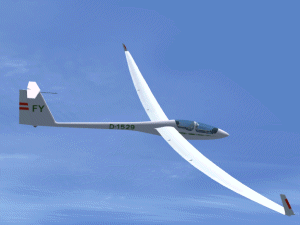
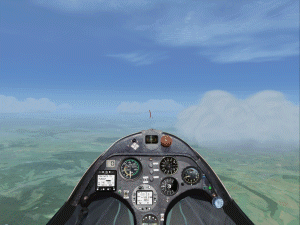
The ASH 25 is a double-seat glider of the Open Class with a span of 26 m
with winglets and a glide ratio of max 60:1. Flaps (postiv and negative), flexible wings
and a water ballast system are available in the FS model .
The FS9 version has no water ballast system and is flying with full tanks, the flexible wings
only dependent on airspeed and positive g-forces at this time.
The bending in the FSX version however is dependent on the air speed, positive and negative forces,
water ballast, forces during standing on ground and concussions when landing.
My special gratitude is for Ian Forster-Lewis. Ian made this options possible by helping me with his
wonderful programs and, of course, Max Roodveldt for his CAISet gauges built in into a lot of my gliders!.
Glide ratio 1:60 at 95 km/h
Schleicher ASH 25 panel version 'B21' by Ian Forster-Lewis
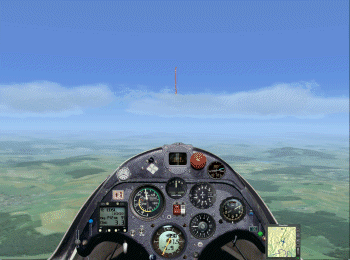
The 'B21' variant of the ASH25 by Ian Forster-Lewis (only for FSX) has a competition-standard instrument set based around the
Cambridge 302 Flight Computer. Variometer (compensated vertical climb) gauges show
'Total Energy', 'Netto' and 'Speed to Fly' readings concurrently.
The '302' flight computer computes in real-time the optimal 'speed to fly' for the current conditions
and moves its main needle to show the pilot whether it would be appropriate to speed up or slow down.
A decimal display shows the expected arrival height at the current selected waypoint, particularly important
on 'final glides' in such a high-performance glider.
Combined with the GPSNAV and GPSMAP , the glider gives comprehensive information for the pilot
to maximise cross-country performance.
The GPSNAV now allows the user to select any waypoint in the flightplan and the GPSMAP can display the position
of other aircraft.
The 'B21' instruments including the yawstring are all 'XML' instruments, avoiding the use of
compiled 'dll' programs, so the installation is complete after a simple drag-and-drop of the aircraft into the FSX folder ...
... read more about these gauges at Ian's detailed documents on his
web page !
Schleicher ASW 15 B
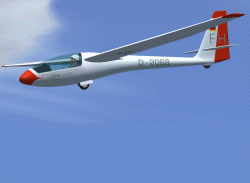
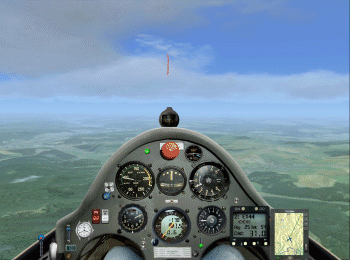
The ASW 15 is a single-seater of the Standard Class and started in 1968 it's first flight.
The ASW 15 B following in the year 1973 was equipped with water ballast and retractable gear
construction.
Also the FSX version is fitted out with a water ballast system by Ian-Forster-Lewis.
Thanks to Kurt Pelto who investigated for me and to Jaroslav Buryan for his beautiful cockpit picture.
Glide ratio 1:38 at 90 km/h (dry)
Schleicher ASW 19 B
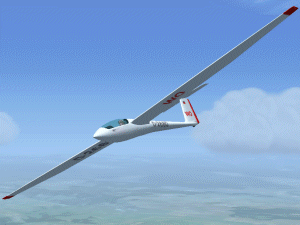

The ASW 19 is a single-seater of the Standard Class and started in 1975 it's first flight. This glider has the
wings of the ASW 15. 425 pieces were built.
Glide ratio 1:38.5 at 95 km/h dry Ballast, 112km/h wet
Schleicher ASW 17
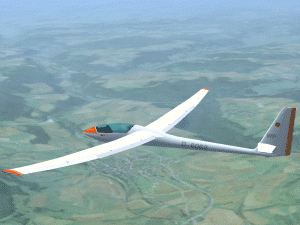
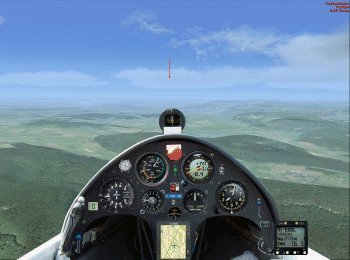
The ASW 17 is a further development of the ASW 12 . Approx. 55 pieces between 1972 and 1976 were built.
The FSX version is fitted out with a water ballast system of Ian Forster Lewis, flaps and flexible wings.
A version for FS9 isn't available at this moment.
The panel picture is from Thomas Stolze.
Glide ratio 1:48.5 at 100 km/h
Schleicher ASW 20 B - 15m
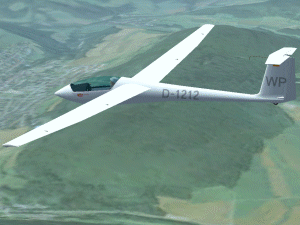
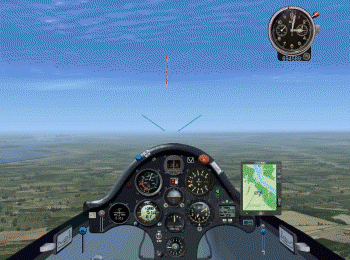
There were 5 different versions of the ASW 20. This FSX version has 15 m span, flaps
and a water ballast system of Ian Forster Lewis. Altogether from 1977 to 1990 over 900
ASW20 gliders were built.
The FS9 version is not available at this time.
Thanks to Britta Pulz who provided me with the panel picture !
Glide ratio 1:43 at 120 km/h
Schleicher ASW 20 BL -16.6m
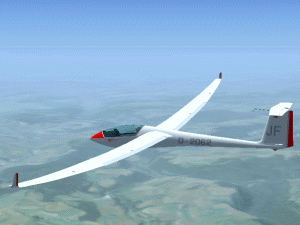

This FSX version version has 16.6 m span, flaps,
flexible wings with winglets and a water ballast system of Ian Forster Lewis.
The FS9 version doesn't have any flexible wings at this time.
Thanks to Britta Pulz who provided me with the panel picture !
Glide ratio 1:46.5 at 105 km/h
Schleicher ASW 22 BL
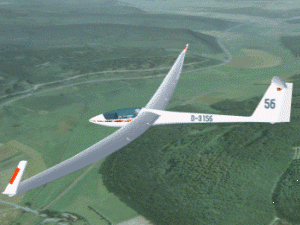
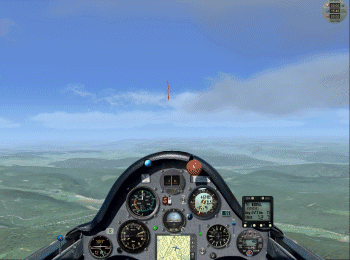
The ASW 22 BL is a Open Class High Performance Glider, which has been further developed
from the ASW 22. The ASH 25 wing with its larger span and greater strength has been combined with the
upgraded fuselage of the ASW 22.
First flight was in 1991
This glider is not available for FS9.
Glide ratio 1:62 at 110 km/h
Schleicher ASW 27 B
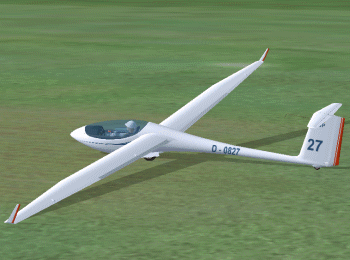
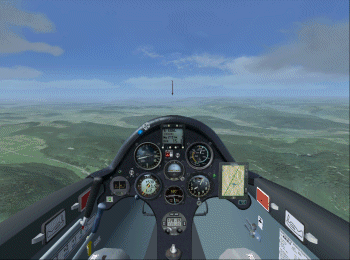
The ASW 27 B, a glider of the 15 m class is the successor of the ASW20 based on the fuselage of the ASW 24
with a new, only 97 square feet wing.
The first flight was in 1995. Equipped with flaps, winglets, water ballast system and 3-storied spoilers on the
top side shows this glider very high flight performances.
The ASW 27 is authorized for cloud flight and simple aerobatics without water ballast.
Unfortunately, a FS9 version isn't available.
Thanks to Britta Pulz for her panel picture!
Glide ratio 1:48 at 125 km/h (with full water ballast)
Schleicher ASG 29


The ASG 29, a high performance glider of the 18 m class resulted from the ASW 27 B.
The wings are divided into 4 segments and so it is possible to fly with a reduced span width of 15 m
in the FAI 15 m class, too.
The ASG 29 is prepared for the installation of an auxiliary engine.
First flight was in 2005.
FS9 version isn't available..
Glide ratio 1:52 bei 125 km/h (with full water ballast)
Schleicher ASK 21
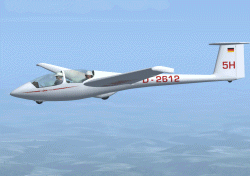
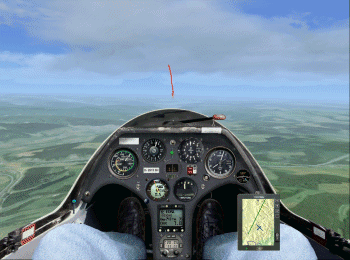
The ASK 21 version 'CAISet' for FSX:
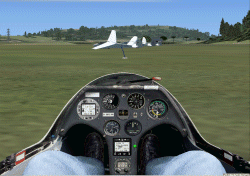
The ASK 21 was built since 1979 with over 650 pieces and is standard as a glider for
the training today. The aircraft is robustly, flies himself easily and is suitable for
aerobatics. Thanks to Roland Stuck which helped me in many detail questions and to Max
Roodveldt which programmed the instruments of the versions I made before. Also thanks to Nico Müller for the opportunity
to make pictures in Boberg.
Thanks to Mark Aisthorpe for his tips regarding camera and seat definitions in FSX !
Glide ratio 1:33.5 at 90 km/h
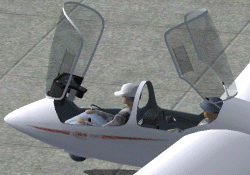
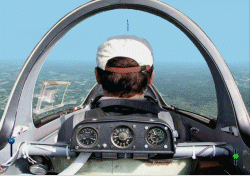
Schleicher ASK 23
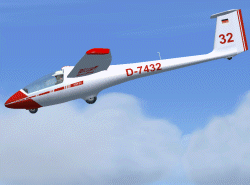
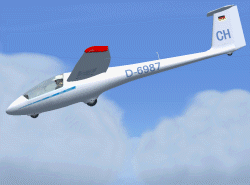

The ASK 23 is a single-seater version of the ASK 21 for flight students, which were trained on single-seaters
after their first solo flights. This glider made the first flight in 1983.
153 pieces were built between 1983 and 2001.
The cockpit corresponds to that one of the ASK 21 in the essential features.
Glide ratio 1:34 at 95 km/h
Glaser-Dirks DG-101 G (15m)


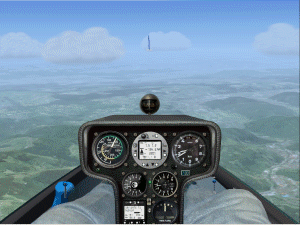
The DG-101 G, an one seat glider for performance,
first flight in 1974. The DG-100 in this time was called of many glider pilots as one
of the most beautiful gliders of the Standard Class. The long tail unit lever arm provides
for high flight stability.
The FSX version of the DG-101 G is fitted out with a water ballast system
The zip files of the DG-101 G content 2 panels, one in black colour and the other one in wood.
Glide ratio 1:39 at 105 km/h
Glaser-Dirks DG-202 (15m/17m)
15 m span:
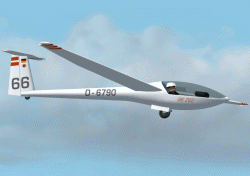
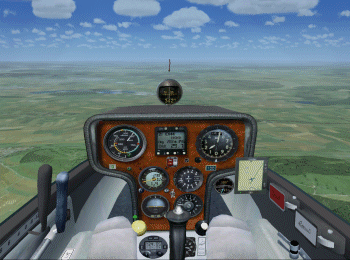
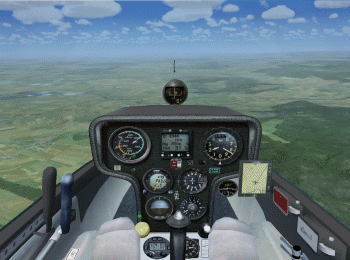
DG-202, one seat glider for performance, first flight in 1977.
This glider is equipped with flaps which permit positive and negative flap positions.
The FSX version of the DG-202-15 is fitted out with a water ballast system.
Thanks to Phillip Winkelmayer for his panel picture and his hints correspondig flaps positions !
Glide ratio 1:42.5 at 110 km/h
17 m span:



DG-202 in 17m span
Glide ratio 1:45.5 at 110 km/h
Glaser-Dirks DG-600 with 15,17 and 18m span
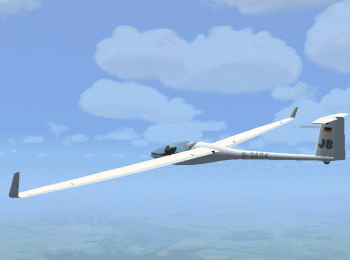

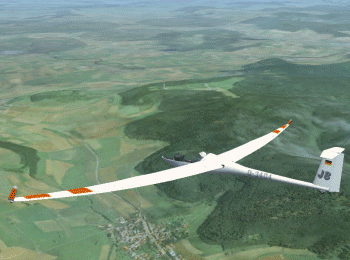
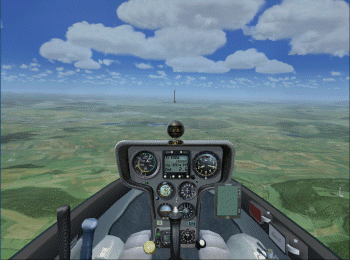
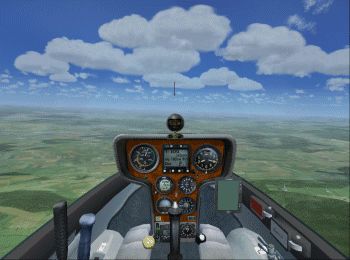
The DG 600, a performance single-seater, first flight in 1987.
The glider is equipped with Flaperons. Here the ailerons extend over the complete
wing length and you can used them as flaps at the same time.
The DG 600 was offered from the beginning with 15 and 17 meters of span.
1991 variants also with 18 meters span and winglets were available.
After the moulds were destroyed by a fire in the production halls in 1992,
the production was stopped after only 112 units. The successor was
the DG 808.
Thanks to Jörg Baumhöfener,co-owner of the D-3404, for his pictures and documents !
Glide ratio 1:46, 1:49 and 1:50
Glaser-Dirks DG-800S-18
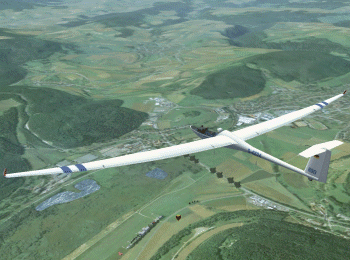
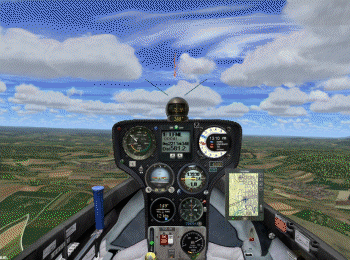

Die DG-800S , a follower of the DG-600.
Glide ratio 1:52 at 110 km/h
Eta
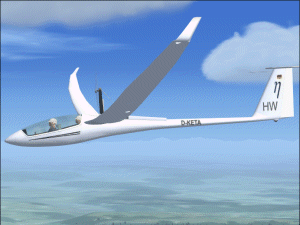
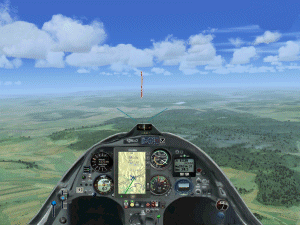
The Eta is a self-launching two-seater Open Class glider with a wingspan of 30.90 m.
The world's largest and most powerful sport glider has a best glide ratio of about 70.
The first flight was in 2000.
Glide ratio 1:70 at 130 km/h
Glasflügel Standard Libelle 201 B
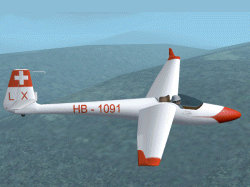
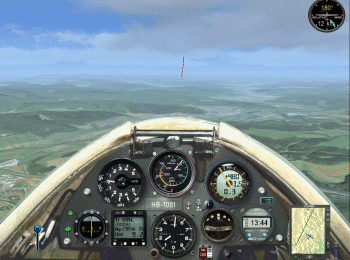
The Standard Libelle has a beautifil aerodynamic design.
The fuselage height is only 84 cm.
600 pieces were built between 1967 and 1974 (201 + 201 B).
The canopy can be raised a bit during the flight for the purpose of ventilating.
The FSX version is fitted out with a water ballast system by Ian-Forster-Lewis.
Thanks to Werner Ochsner for the many pictures and documents of his glider!
Glide ratio 1:38 at 94 km/h
Rolladen-Schneider LS-4 a
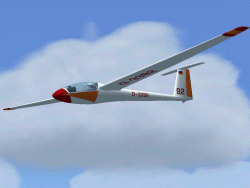
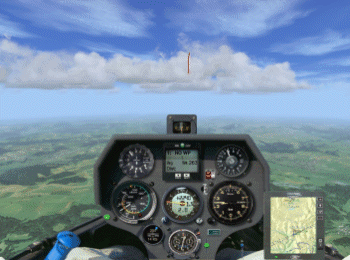
LS-4 a , a Standard Class glider, flew first in 1980
The FSX version is fitted out with a water ballast system by Ian-Forster-Lewis (160 l).
Thanks to Jacob Thomsen for his beautiful panel picture and to Sebastian Pfohl for his aircraft picture !
Glide ratio 1:40.5 at 110 km/h
Rolladen-Schneider LS-4 WL
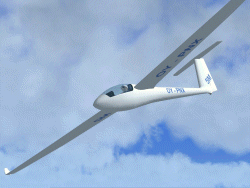
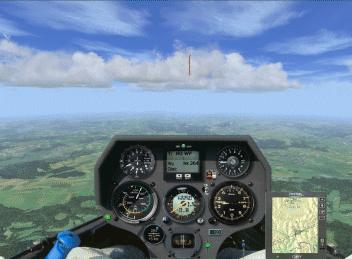
LS-4 WL , like above but with winglets
The FSX version is fitted out with a water ballast system by Ian-Forster-Lewis (100 l).
Glide ratio 1:40.5 at 102 km/h
Rolladen-Schneider LS-7 WL
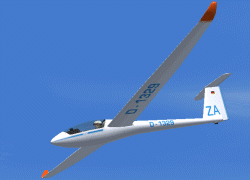
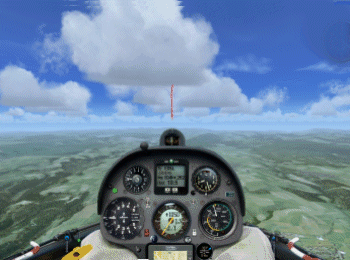
LS-7 , a Standard Class glider, flew first in 1987.
The FSX version is fitted out with a water ballast system by Ian-Forster-Lewis.
Thanks to Jacob Thomsen and Thomas Stolze for their beautiful panel and cockpit pictures !
Glide ratio 1:43 at 105 km/h
Rolladen-Schneider LS8-sc neo

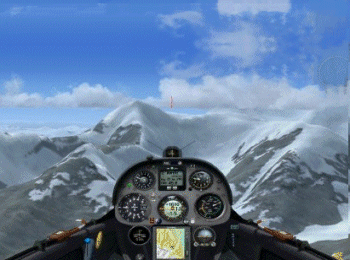
LS8-sc neo , the 15m version of the LS8 with new, optimized winglets. The neo types of the LS aircrafts are manufactured by DG Flugzeugbau.
Glide ratio 1:44 at 100 km/h
Rolladen-Schneider LS8-18
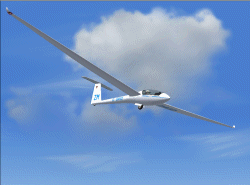
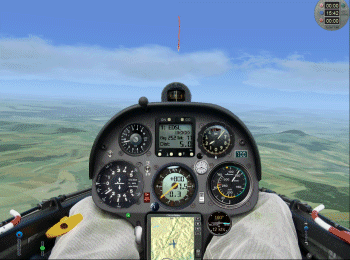
LS8-18 , another beautiful glider of the LS series.
The FSX version is fitted out with a water ballast system by Ian-Forster-Lewis.
Thanks to Thomas Stolze for his numerous pictures !
Glide ratio 1:49.5 at 110 km/h
Schempp-Hirth Discus CS
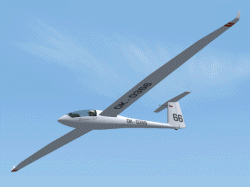

This Discus CS is a licence-produced version of the Discus b manufactured by the Czech Orlican company.
The CS version is identical to the machines manufactured by Schempp-Hirth.
The FSX version is fitted out with a water ballast system by Ian-Forster-Lewis.
Glide ratio ~1:43 at 105 km/h
Schempp-Hirth Discus 2b
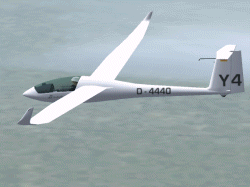

Glide ratio ~1:45 at 105 km/h
Schempp-Hirth Duo Discus

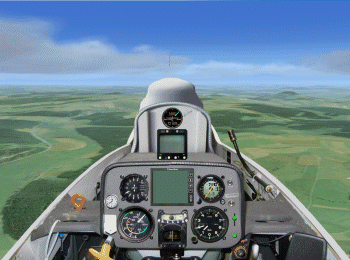

The Duo Discus is a two seat glider with high performance for advanced training and instruction cross country flying.
First flight in 1993.
Two models and instrument panels are in this package (Front and Rear).
Michael Bourgeois sent me the rear panel picture.
Glide ratio 1:43 at 100 km/h
Schempp-Hirth Duo Discus 'X'
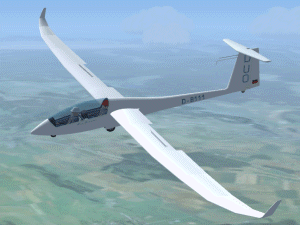


The Duo Discus 'X' is a further development of the Duo Discus. New airfoil,
flaps-linked-to-air-brakes system, winglets and damped main wheel at the original plane.
First flight April 2005.
Michael Bourgeois sent me the rear panel picture.
Glide ratio 1:46 at 100 km/h
Grob G103 Twin Astir
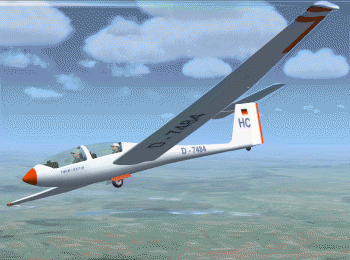
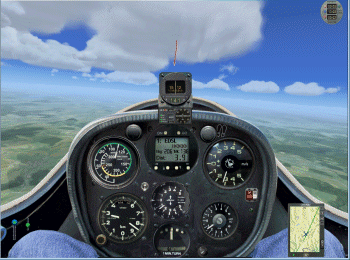
The G103 Twin Astir is a German high performance two-seater sailplane made by Grob Aircraft in
Mindelheim/Allgäu.
Glide ratio 1:38 at 110 km/h
Grob G103 Twin II Acro
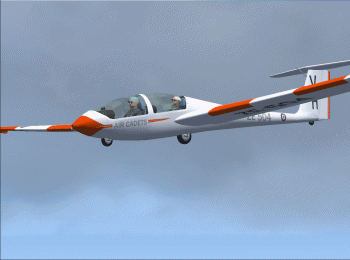
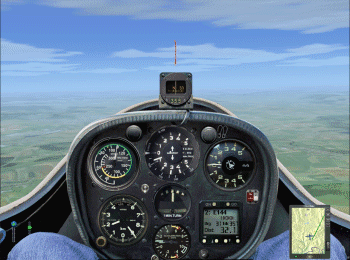
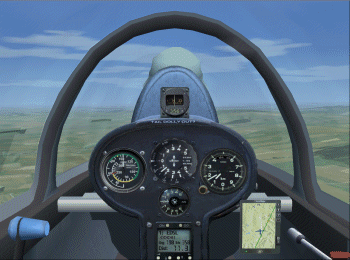
The Twin II Acro is a variant of the Twin II with an amplified structure and is designed for training,
high performance and aerobatic flying. (G limits +6/-4g).
The Royal Air Force acquired 100 Acros (known as the Viking T Mk1) for its Air Cadet training program.
A total of 549 were produced, including 100 Vikings for the UK Armed Forces before it
was succeeded in production by the G103C Twin III in 1989.
Glide ratio 1:38 at 105 km/h


